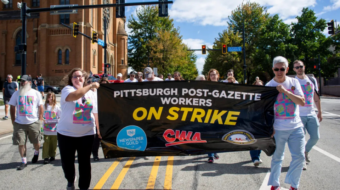While the future is looking up for General Motors and its high-priced execs, it’s anything but good for workers as the company is moving quickly to slash its labor expenses. General Motors has just told Wall Street analysts it will take advantage of its new cost-cutting labor agreement with the United Auto Workers to reduce its annual U.S. labor costs by $5 billion by 2011. Wall Street is also pushing GM to close an additional three to four plants. This is happening even though cutting wages and closing more plants can only exacerbate the nation’s overall economic downturn.
In the announcement, GM said it will offer buyouts to 46,000 of its 73,000 employees next month. Unlike previous buyouts that drastically reduced the company’s workforce, this one aims to drastically reduce the workers’ pay.
Workers accepting a buyout will be replaced by workers with a pay and benefits package totaling $26 an hour, compared to the current package of $62. The new GM-UAW agreement, signed last September, allows GM to pay new hires in non-core jobs approximately 50 percent less than other workers, and all new hires, core and non-core alike, will be covered by a new health and benefits package that is significantly less than the one covering current employees.
All this is happening while GM set 2007 sales records in Europe, Asia and other non-North American markets. And the future is looking even better as far as GM is concerned: within 10 years, CEO Rick Wagoner said the company will probably get 75 percent of car and truck sales from outside the U.S. as it expands operations and sales worldwide.
The company’s increased profits, combined with its wage cuts, will only widen the pay gap between workers and the top brass. UAW President Ron Gettelfinger has noted that Japanese executives make 43 times less than their U.S. counterparts.
Ford Motor Co. announced it too would reduce labor costs by offering buyouts and early retirement packages to its 54,000 hourly employees. Under Ford’s new contract with the UAW, the company can replace workers taking the buyouts with workers who would be paid $14.20 per hour — half the wages of current workers.
Unlike the contract with GM, all new Ford hires get $14.20 an hour and can be assigned to any nonskilled job at the plant. The contract allows up to 20 percent of Ford’s U.S. hourly workforce to be paid at this low rate, but that figure can grow. Jobs that are currently outsourced can become in-house, paid the lower rate and not count against the 20 percent cap.
While GM is hoping 20,000 workers will accept the buyout and be replaced with the lower-wage workers, the result will be 20,000 workers who will have even less to spend on mortgage payments, their kids’ college tuition and everything else working families are struggling with. The same goes for Ford, which hopes to actually reduce its overall workforce in addition to lowering the pay of new workers. The end result? The communities and states autoworkers live in will receive less tax revenue and retail stores will see fewer people walking through the door.
And the future for GM and Ford? The additional annual billions GM and Ford take from the workers will enrich the few at the expense of the many. What’s good for GM and Ford is definitely not good for their workers.
jrummel@pww.org









